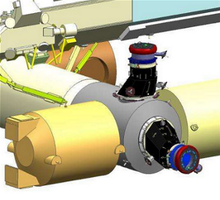- NASA Docking System
-
The NASA Docking System (NDS) or international Low Impact Docking System (iLIDS) is a spacecraft docking and berthing mechanism being developed by NASA for the next generation of space exploration vehicles, such as the Multi-Purpose Crew Vehicle and the Commercial Crew vehicles. It is androgynous, the first system to use low impact technology and the first system to allow both docking and berthing.[1] Once mated NDS can transfer power, data, commands, air and in the future will be able to transfer water and fuel. It features pyrotechnics for contingency undocking, and is capable of supporting both autonomous docking or piloted. It is compatible with the International Docking System Standard (IDSS), which is an attempt by the ISS Multilateral Coordination Board to create a docking standard. The Transfer Passage has a diameter of 26.97 inches, which can be increased to 32.00 inches by removing the petals.[2]
In form and function NDS bears some resemblance to the Androgynous Peripheral Attach System (APAS-95) mechanism already in use on the Pressurized Mating Adapter (PMA) attached to the International Space Station, but is not compatible with it so NDS APAS Docking Adapters (NADA) will be attached to the PMAs, one at Node-2 forward, the other at Node-2 zenith.[3]
The mechanism is covered by US patent 6354540,[4] titled "Androgynous, Reconfigurable Closed Loop Feedback Controlled Low Impact Docking System With Load Sensing Electromagnetic Capture Ring."
Contents
History
Johnson Space Center began development in 1996, then it was known as the Advanced Docking Berthing System[5] and eventually the X-38 Low-Impact Docking System.[6][7] The X-38 was canceled in 2002, development of the mating system continued but its future was unknown. In 2004 George Bush announced his Vision for Space Exploration and NASA's 2005 Exploration Systems Architecture Study was created in response, recommended to use the Low Impact Docking System (LIDS) on the Crew Exploration Vehicle and all applicable future exploration elements.[8] The Hubble Space Telescope received the Soft-Capture Mechanism (SCM) on STS-125. The SCM is meant for unpressurized docking, but uses the LIDS interface to reserve the possibility of an Multi-Purpose Crew Vehicle docked mission. The docking ring is mounted on Hubble's aft bulkhead. It will be used for safely de-orbiting Hubble at the end of its service lifetime.[9]
In February 2010 the LIDS program became modified to be compliant with the IDSS and became known as the international Low Impact Docking System (iLIDS) or simply the NASA Docking System (NDS).[1] In May of 2011, the NDS critical design review was completed and qualification is expected to be completed by late 2013.[3]
Bigelow
Bigelow Aerospace has expressed interest in licensing the LIDS technology from NASA for its space station technology development program. As of 2007[update] Bigelow was planning to equip its Sundancer and BA-330 expandable space modules with both a Soyuz-style docking system on one end and the NASA-standard Low Impact Docking System on the other.[10] During the summer of 2011, news had been made available that Bigelow was considering to use NDS on their modules.[11]
References
- ^ a b NASA Docking System (NDS) Technical Integration Meeting (2010-11-17)
- ^ "NASA Docking System (NDS) Interface Definitions Document (IDD), page 22". NASA. August 15, 2011. JSC-65795 Revision E. http://dockingstandard.nasa.gov/Documents/JSC65795_NDS_IDD_RevE.pdf.
- ^ a b Bayt, Rob (2011-07-26). "Commercial Crew Program: Key Drving Requirments Walkthrough". NASA. http://commercialcrew.nasa.gov/document_file_get.cfm?docid=107. Retrieved 27 July 2011.
- ^ US 6354540
- ^ Low Impact Docking System (2009-02)
- ^ Advanced Docking/Berthing System - NASA Seal Workshop (2004-11-04)
- ^ Advanced Docking Berthing System
- ^ NASA's Exploration Systems Architecture Study - 5.3.4 Docking Mechanism/ISS Docking Module Trades (November 2005)
- ^ NASA (2008). "The Soft Capture and Rendezvous System". NASA. http://www.nasa.gov/mission_pages/hubble/servicing/SM4/main/SCRS_FS_HTML.html. Retrieved May 22, 2009.
- ^ Covault, Craig (2007-04-08). "Bigelow Reveals Business Plan". Aviation Week. http://www.aviationweek.com/aw/generic/story_generic.jsp?channel=awst&id=news/aw040907p2.xml. Retrieved 2010-07-20. "equipped with a Soyuz type docking system at one end and a new NASA developed advanced lightweight Low Impact Docking System on the other end"
- ^ "ISS Interface Mechanisms and their Heritage". The Boeing Company. 2011-09-02. http://ntrs.nasa.gov/archive/nasa/casi.ntrs.nasa.gov/20110010964_2011009594.pdf. Retrieved 6 September 2011. "The mechanism to be used for the interface between the CST-100 and the Bigelow module was originally an APAS, but the NDS platform is also consideration due to its implementation as part of the International Docking System Standard (IDSS)"
- James L. Lewis, Advanced Docking Berthing System. NASA technical publication. Johnson Space Center.
- James L. Lewis, Monty B. Carroll. Prototype Low Impact Docking System. NASA technical publication.Johnson Space Center.
External links
- NASA Docking System webpage
- History of Docking Systems (ppt), NASA poster.
Categories:- Spacecraft components
- Spacecraft docking systems
Wikimedia Foundation. 2010.


